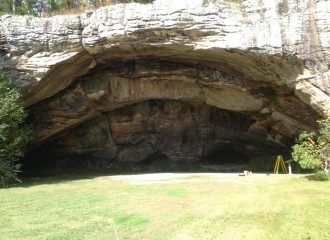Would you like to go visit a shelter in person after reading about them? While many bluff shelters in the Ozarks are on private land and unavailable for you to visit, there are several shelters in parks or other publicly accessible areas that you can go see. Here are descriptions of a few shelters with links for more information on how to get to them. Enjoy the natural beauty and history at these sites, but remember to treat these amazing resources with the respect they deserve.
Visit a Shelter

Cob Cave in the Buffalo National River
You can visit a very large example of a bluff shelter at Lost Valley in the Buffalo National River. Located off Highway 43 in Newton County, Arkansas, the Lost Valley trail takes you through a narrow Ozark valley past a natural bridge or tunnel, to a bluff shelter known as Cob Cave, on to a…

Rock House Cave at Petit Jean State Park
Rock House Cave in Petit Jean State Park is located near Morrilton, Arkansas. The park is located atop beautiful Petit Jean Mountain which rises from the Arkansas River Valley and affords visitors spectacular views. The bluff shelter is located at the end of a short, .25 mile hike over somewhat uneven ground. Note the geological…

Indian Rock Cave or Edgemont Shelter at Fairfield Bay
This shelter goes by many names which can cause some confusion. It is currently called “Indian Rock Cave” or “Indian Rock House,” and is located in the town of Fairfield Bay. Fairfield Bay did not exist before the 1960s and the closest town to the shelter when Dellinger visited it in the 1930s was Edgemont. …
Read more Indian Rock Cave or Edgemont Shelter at Fairfield Bay

Indian Rockhouse Cave on Panther Creek in the Buffalo National River
Indian Rockhouse Cave in the Buffalo National River is one of the most spectacular Ozark shelters currently interpreted to the public. It is a large shelter with a natural “skylight, ” and a large spring or underground creek that surfaces briefly at one end of the shelter. It is also the most difficult to access…
Read more Indian Rockhouse Cave on Panther Creek in the Buffalo National River